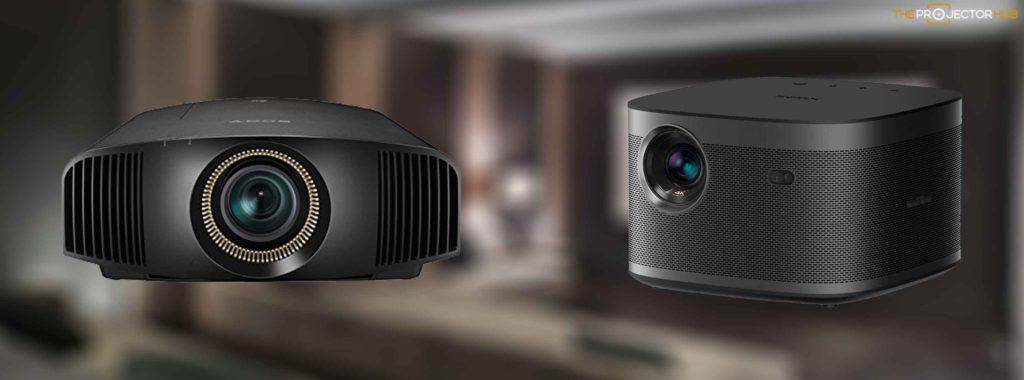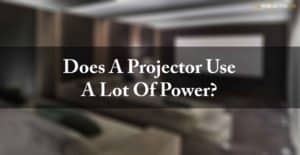 When looking for a new projector, one of the most important questions to ask is “does a projector use a lot of power?”. Some people might be worried that using a projector will significantly increase their electricity bill.
When looking for a new projector, one of the most important questions to ask is “does a projector use a lot of power?”. Some people might be worried that using a projector will significantly increase their electricity bill.
However, this won’t be the case if you purchase an energy-efficient model. In fact, many projectors use less power than other electronics products. Average projectors can use anywhere from 150-800 watts per hour (really averaging to around 300 watts). To have something to compare this to, the average television uses 80-400 watts per hour. So don’t let concerns about power usage keep you from buying a projector – in most cases, it won’t affect your electricity costs.
Does A Projector Use A Lot Of Power? 2022 Guidelines
Types of projectors and the power they use
Laser Projectors:
Laser projectors are the market’s newest and most popular type of projector. They use a laser light source, which is more energy-efficient than traditional lamps. Laser projectors also have a longer lifespan, saving you money in the long run.
The power consumption of a laser projector depends on the model but is typically between 150 to 800 watts per hour. They have the highest average consumption rate out of any projector type.
LED Projectors:
LED projectors use a lot less power than traditional projectors. LED projector bulbs also last a lot longer than traditional ones, so you’ll save money on replacement bulbs. The wattage needed to operate a LED projector is between 20 to 200 watts for one hour. LED projectors have power requirements but are capable of producing a wide range of color types.
LED only lampless projectors use an energy amount that is similar to the amount used by huge LED TVs (from 120 to 400 watts).
LCD Projectors:
An LCD projector uses a lamp to project an image onto a screen. An LCD projector’s power consumption depends on the projector’s type and size. A small LCD projector may use as little as 50 watts, while a large LCD projector can use up to 400 watts. This means 50 to 400 watts of power is used an hour for LCD projectors.
DLP Projectors:
A DLP projector uses the oldest type of projector technology, and they are also the most common type of projector on the market. DLP projectors use a chip that has hundreds of tiny mirrors on it.
Each mirror represents a pixel, and when the projector is turned on, these mirrors reflect light either through the lens or directly into your eyes. DLP projectors are known for being very bright, and they can project images onto any surface. DLP projectors use 150 to 350 watts, making them very energy efficient.
Hybrid projectors:
These projectors use an LCD and an LED light source. They are very energy efficient and use less power than traditional projectors. The power consumption of a hybrid projector is typically between 20 to 200 watts.
Battery-powered Projectors:
These projectors are designed to be used with a battery, which means they use less power overall. The battery ojn these projectors are known to last for up to 2 to 5 hours. They typically use around 10 to 70 watts of power, making them a great option for those wanting to save on their energy bill.
The following factors play into how much electricity projectors use.
Screen size:
The size of your projector screen will affect how much power your projector uses. A larger screen will require more light to illuminate, so the projector will use more power. If, in a projector’s specifications you see that it includes large images and high resolution displays, it will likely require a high lumen output. If, in the specifications you see that a projector projects images that are large in size, you can bet that it will use more energy than smaller projectors.
You can save power by using a smaller projector if you have a small screen.
Device usage:
The size of the device doesn’t really matter if you use it all the time – it will eventually end up run up your electricity bill. In comparison to a television, projectors don’t use a lot of energy, mainly because they aren’t designed for continuous use. If they are used for long time periods continuously the internal mechanisms will eventually overheat and burn out.
This actually helps the energy efficiency case for them as they can’t be used continuously.
Brightness:
The brightness of your projector also affects how much power it uses. A brighter projector will use more power than a dimmer one. You can save power with a dimmer projector if you have a small screen. And your projector is low lumens, which will save you even more power.
Resolution:
High-quality resolution projector models will use more power than lower-quality resolution models.
How can You measure how much energy is being used by a projector?
Check device specifications:
Before you get your hands dirty trying to figure out how much energy is being used by a projector, you could always just check the device specifications. Checking the specs will allow you to see the device’s wattage settings. All projectors nowadays come with user manuals or labels that show these specs. Another option would be to check the projector’s model on the manufacturer’s site – they usually give very detailed descriptions on the device that go over the power consumption and specs.
Watt Measuring Devices:
Another option would be to use a watt measuring device to measure the projector’s power consumption – this will help you to get around averages and have a perfect understanding of just how much energy your device is using.
All you have to do is plug your device into the watt measuring device and it will check how much energy is being used by it when placed in the on position.
Conclusion Paragraph: Does A Projector Use A Lot Of Power
In conclusion, projectors use a variety of power depending on the type of projector it is. The power usage for each type of projector is different. Laser projectors use the least amount of power, while DLP projectors use more power.
When choosing a projector, make sure to take into account the power usage of the projector. Choose an energy-efficient model to save money on your electricity bill.
